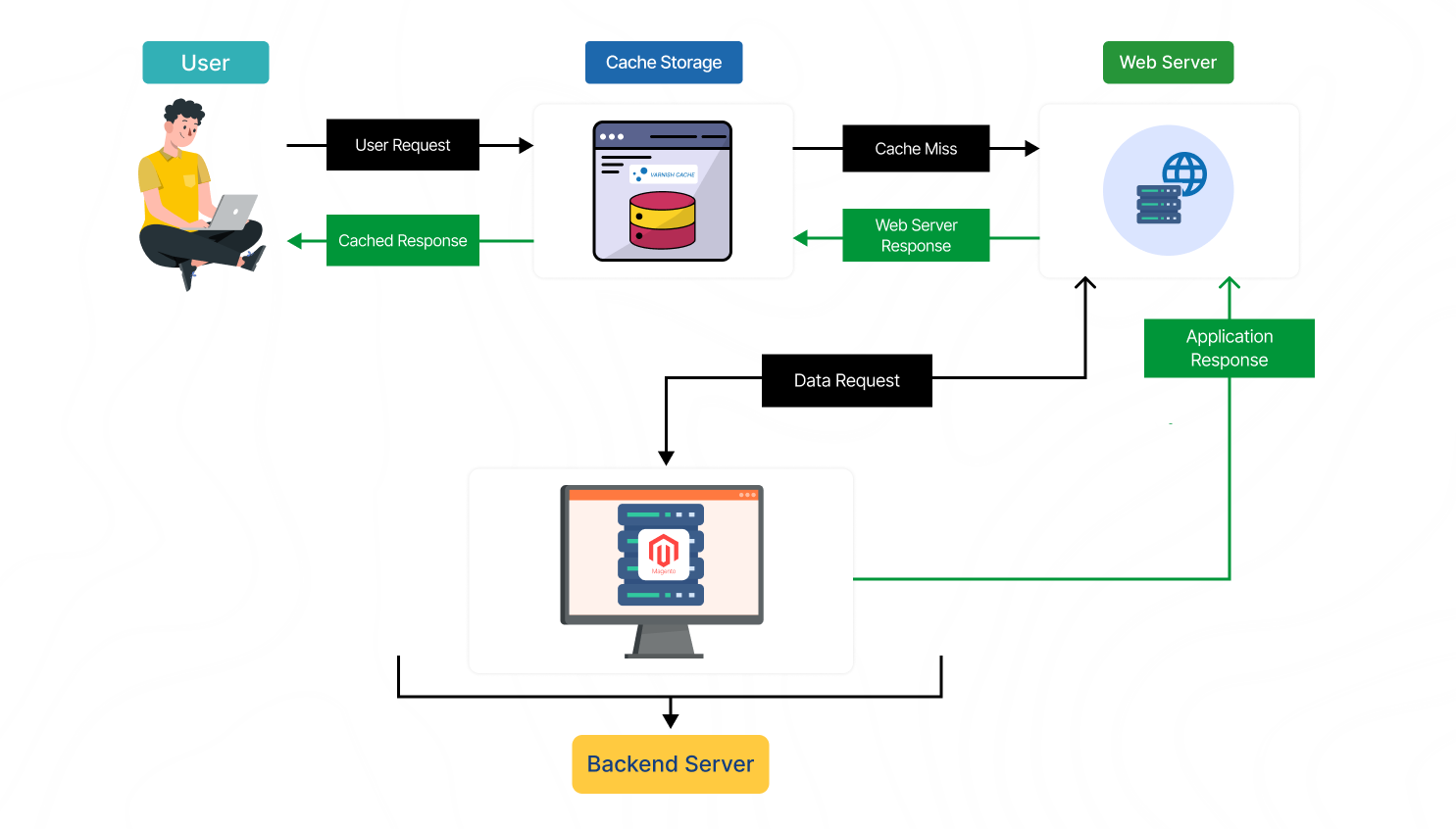Use Magento with Varnish for A Better User-Experience!
Is your Magento store lagging too? Magento’s loading times have become a common problem for online business owners. Slow loading times can lead potential customers to exit your websites. Every click counts and delays in page load can lead to losses in terms of sales, and customer retention.
When it comes to speed, Varnish cache is one of the most popular choices for Magento 2. But what is Varnish? In this blog we are going to introduce you to Varnish for Magento!

Varnish in detail!
Before delving into the details of Varnish, it is essential to understand caching.
Caching is an important element for smooth web server performance, especially for complex applications like Magento 2. By storing a copy of frequently accessed webpages, caching significantly reduces application load and improves your page response times. Now, what does Varnish has to do with caching?
Varnish uses http caching strategies to optimize your Magento performance.
Varnish functions as a caching reverse proxy, positioned strategically between your customers and the webserver. When a user visits your page for the first time, the request for the page data is sent to the webservers. The server finds the file associated with the request and sends it back to the user. After configuring Varnish, the first request of any page is delivered in the same manner. However, it creates a cached copy of the result and uses it when the same page request is made again. Generally, Varnish stores the cached webpage data in fast access hardware’s like RAM.
Hence, Varnish efficiently retrieves the cached content, dismissing the need to interact with the webserver. In case the page cache isn’t available, it directs the request to the main server. Retrieving page data and delivering them to the users becomes easier with Varnish cache. This includes caching all the page elements like HTML structure, CSS Styles, Java Script, and image assets.
Why your Magento needs Varnish?
But why caching? Have you ever wondered why is caching so essential for high-end applications like Magento? Caching helps the webservers to delivers webpage data and information at a comparatively higher speed. This majorly reduces the load on the backend resources. But it not the limit. Let’s look at some of the reasons why caching is important for your Magento stores.
- Slow website loading times: One of the most immediate consequences of not caching webpage data is slow website performance. Without caching, every single user request is processed directly from the servers hence, this leads to higher loading times. Especially for first time visitors.
- Limited Scalability: When your website attracts a heavy traffic, there are chances that your webservers may not be able to handle the repetitive requests. This limits your website’s capacity to scale and hence it often leads to crashes during peak times.
- Increased server load: Without a caching software, your webserver handles all the requests. This puts a heavy load on server resources and hence makes it difficult for registering user data and managing similar databases.
- Reduced engagement: Users are most likely to exit a slow loading website which highly reduces chances of conversion. Apart from this, dissatisfied customers can often contribute to a negative review of the company. Hence affecting your website’s traffic and reach.
- Lower SEO rankings: A reduced web traffic often leads to a decline in the organic visibility. Your website might struggle to compete with fellow competitors and hence it leads to lower SEO rankings.
How Varnish functions in Magento?
Configuring Varnish in Magento, even with the minimal set of parameters can be a complex process and requires a compatible set up. However, after configuring it functions with a simple mechanism. Given below is a breakdown of how Varnish functions in Magento.

- Initial Request: When a user requests a page on your Magento store, the requests is processed through Varnish. This is when Varnish checks for any existing cache.
- Cache Check: Varnish checks for existing cache of the requested page. If it already has the page cache, it directs it to the user. However, if there is no cache found, it sends a request to the server end.
- Content Generation: Upon a new request from the user, your Magento web servers generates the page. A few elements of the web page include HTML structure, CSS style, and JavaScript code.
- Caching the response: This is when Varnish creates the cached content. When the response from the Magento is sent back to the users, Varnish creates a cached copy of the page content within its memory storage.
- Delivery: Varnish then delivers the cached content instead of contacting the Magento servers to generate the content.
By correctly configuring Varnish cache into your Magento, you’ll automatically be able to reduce your website load time. However, there are a ton of other ways in which you can benefit your Magento store. Let’s look at those.
But why Varnish?

Varnish cache offers a compelling performance boost for Magento stores. It plays a crucial role in benefiting both the website performance and enhancing its user experience. Mentioned below is a list of other ways in which Varnish benefits your Magento:
- Better speed & performance boost: By configuring Varnish for your Magento stores, you can see a dramatic change in your page loading times. When the cached content is served directly from the Varnish’s memory, it significantly reduces the page load times leading to a smoother browsing experience for customers.
- Improved SEO value: Google is known to prioritize faster loading websites. By reducing the load on your Magento servers, Varnish improves the page load times. Hence, this can impact your store’s ranking in search results. Thus, improving your SEO.
- Responsive time and latency: By using cached content Varnish gives immediate response to user requests instead of deriving it from the servers. With reduced latency, it makes your websites more prone to customer visits.
- Reduces server load: Varnish handles majority of user requests by serving cached page data. This frees up Magento’s servers and resources for other critical functions like handling website traffic spikes. Hence your Magento will handle less load and will provide a more reliable user experience for customers.
- Improved User Experience: With a quick page response, improved loading speed, enhanced latency and better SEO rankings, the number of customers exiting your page reduces. This reduces the bounce rates and increases the conversion rates.
Varnish positively impacts both the performance and customer experience of your website.
Wait no more! Integrate your Magento stores with Varnish Cache and get a hands-on on extensive features and expert support. This is a great way to optimize your website speed and loading times. Anyhow Infosystems simplifies the process of setting Varnish for your stores.





